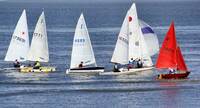Too little and too late.
The report on gathering grounds influenced the management of reservoirs but most suppliers were reluctant 'to withdraw from the position for which they had fought so bitterly in the past' (Institution of Water Engineers 1963). Yet there were still no outbreaks of waterbourne disease caused by reservoirs and in 1963 the water engineers set up a committee to review the situation. After taking evidence, the Institution of Water Engineers reported that fishing and sailing could be regarded as fully acceptable uses, providing they are tightly regulated by clubs, but that swimming and water skiing should be prevented. No mention was made of subï¾aqua diving. The report reminded water engineers of the growing demand for recreation but its conclusions did not represent any advance on the Gathering Grounds Report.
The Institution was however a learned society and it published the debate which took place following publication of the draft report (Institution of Water Engineers 1963). Many of the comments by members were notably more liberal than the overall report. Mr A B Baldwin challenged the terms of reference of the committee because it included only such recreational use as could take place 'without detriment to the public water supply'. He asserted that Britian has 50 million people living in a small space and that the community does not expect water engineers to make every other consideration subservient to water supply. Mr Baldwin pointed out that water authorities were in severe danger of making themselves ridiculous ï¾ some would not allow fishing from boats and others would allow fishing only from boats.
Mr G Delwyn Davies stated that the water engineer's duty was to calculate the risks arising from recreational use and then deal with the risks. He said that a threshold of recreational use must be passed before any increase in pollution becomes evident ï¾ and added that if Manchester Corporation provided special trains so that each of its citizens could go and urinate in Haweswater [Fig 5.3] once a year then 'he doubted whether skilled chemical detection services would discover any increase in pollution at Manchester'.
The practice of letting fishing and sailing rights to private clubs was supported in the 1963 report and remains common. It earns money. But it was rightly criticised in the course of a second debate on water recreation which took place in 1971. Mr G Little said that: 'Surely, this is merely converting the reservoirs into private stretches of water for the relatively small numbers of members in such clubs. This, in turn, defeats the purpose of making recreational facilities available to the public' (Institution of Water Engineers 1963).
A Water Act was passed in 1973 and set up new authorities in England and Wales concerned with all aspects of water ï¾ including recreation. Section 20 of the Act imposed the duty to make provision for recreation whenever 'reasonably practicable':
Every water authority and all other statutory water undertakers may take steps to secure the use of water and land associated with water for the purposes of recreation and it shall be the duty of all such undertakers to take such steps as are reasonably practicable for putting their rights to the use of water and of any land associated with water to the best use for those purposes (Water Act 1973).
It is unfortunate that the phrases 'may take steps' and 'reasonably practicable' were interpreted by the water industry to mean that the duty was discretionary (Dangerfield 1981: 13). There can however be no doubt that Section 20 of the 1973 Water Act led to an expansion in recreational access. A 1977 report on The recreational use of water supply reservoirs in England and Wales (Tanner 1977) said that progress had been made but there was still a long way to go. In 1977, the water industry had 537 reservoirs, occupying 22,885 ha., with an additional 131,958 ha. of associated land, including reservoir banks, operational areas and gathering grounds. This was a larger area of land than that held by the National Trust, which had 162,600 ha. in 1977. Most of the water industry land is in areas of high landscape value. It includes one sixth of the Peak District National Park, one sixth of the Brecon Beacons National Park, one tenth of the Lake District National Park, and one fifth of London's Lea Valley Regional Park. The level of recreation provision at the 537 reservoirs was found to be as follows:
No. with some form of active recreation 344 (64.1%)
No. with fishing 327 (60.9%)
No. with no active recreation except fishing 228 (42.5%)
No. with sailing 84 (15.6%)
No. with subï¾aqua diving 22 (4.1%)
No. with canoeing 19 (3.5%)
No. with rowing 9 (1.7%)
No. with water skiing 4 (0.7%)
No. with swimming 1 (0.2%)
These percentages were pitifully low. In total there were only 71 car parks, 21 picnic areas, 13 viewing points, 3 cafes, 2 childrens play areas and 2 nature trails. Provision was best at the 54 postï¾1960 reservoirs designed and built in consultation with planning authorities. The 57 compensation reservoirs had a very similar pattern of use to supply reservoirs - despite the point, made in both 1948 and 1963, that there is no reason whatsoever to restrict their use. In 1976 provision for recreation was better than in 1904, when one water company permitted fishing at one reservoir, but the statistics indicated very considerable scope for improvement.

